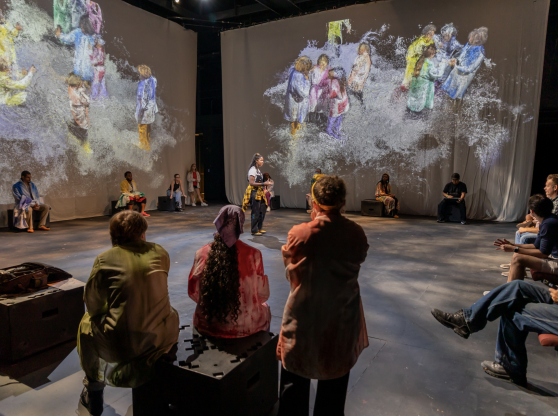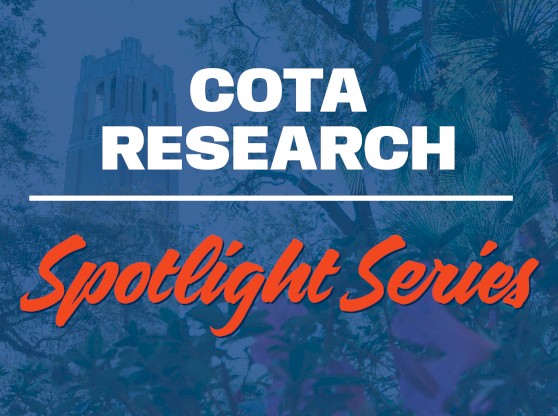As Jerry Uelsmann finished brewing his cup of coffee, he sat down with me at his dining room table. I asked him about working with Moa Petersén, the muse and subject of his latest exhibition. His eyes lit up.
“I’ll tell you more than you care to know,” he said with a smile.
And that’s just how Uelsmann is. Behind the fame, iconic round glasses and disheveled white hair, he’s an open and honest 82-year-old man with a lot to say but few people to say it to. He jokes that the only other heartbeat in the house is his three-legged dog, Lulu.
If you’re unfamiliar with Uelsmann, he is considered to be the “Godfather of Photoshop” but ironically does not use the program. He is known for going against the straight, documentary style photography in the ‘60s and ‘70s with his own dreamlike, black-and-white photos. His innovative photomontage methods take place in the dark room where he selects negatives from his archive and layers them into one composite image.
Uelsmann, a graduate research professor emeritus in the UF College of the Arts School of Art + Art History, also left an indelible mark to the photography program at the University of Florida. After filling a teaching position fresh out of graduate school in 1960, he inspired an interest in photography within the students. Many classes and years later, he still considers Gainesville his home.
Although he is still recognized around the world, he claims his photography is no longer in vogue. Whereas his psychological and emotional based work used to be grouped with Lee Friedlander and Diane Arbus as “the future of American photography,” he feels he has now been gradually written out of that category. This, however, hasn’t stopped him from working.
His latest work has culminated in his exhibition, Confluence | Jerry Uelsmann, which closed Nov. 9 after about two months on display in the University of Florida University Gallery. Although he’s no stranger to exhibitions—having done more than 100 all over the world in the past several decades—he said this show feels more personal than many of the others.
Confluence came about after a time of depression in the artist’s life. After his 27-year marriage ended, Uelsmann struggled with bouts of loneliness and took refuge in his art.
“I was shutting down,” he said. “This was the end of my life, and I was alone. I had art to do, but I didn’t feel very positive about it.”
It was during this period that Petersén contacted him. She had included Uelsmann in her Ph.D. thesis on American photography in the ‘70s, but she was interested in doing further research on his work for potential articles. Uelsmann, happy to answer her questions, typed away with his two fingers on the keyboard.
In one of these exchanges, Uelsmann, with a glass of wine and a bit of nerve, suggested a crazy idea. Without knowing anything about Petersén, he invited her to his home in Gainesville to host her and discuss her research in person instead of via email. After a few days she writes back, “I like your crazy idea.”
And thus began Uelsmann and Petersén’s unlikely friendship. Once she arrived from her home country of Sweden, the two bonded in ways difficult for Uelsmann to describe. When he was not answering questions and providing resources for Petersén’s research, the two visited museums, went out to dinner with friends and got to know one another.
Uelsmann said she brought a vitality back into his life and expanded his life in various positive ways. He was not only emotionally overwhelmed to have that kind of contact again but equally overwhelmed to send her away at the Orlando airport once the trip ended.
The two stayed in contact, and when an opportunity to be a keynote speaker for a photography workshop in Norway presented itself, Uelsmann immediately thought of Petersén. He asked her to be his assistant on the trip and to visit her hometown of Bodarp, a small village with a population of about 25. Again, she accepted.
It was through trips such as these that Confluence’s photographs came about. He photographed her in the Swedish forests of her hometown, in his home in Gainesville and in the beaches of Longboat Key. Their close connection permeates each of the photographs.
As an academic, Petersén had little experience in front of the camera, but Uelsmann needed to give her little direction. Still unsure what he would use the photographs for, he tried to pose her in an open-ended manner.
For Petersén, who came across Uelsmann’s name in textbooks as an art history student 15 years prior, it was an interesting experience. Although now she sees Uelsmann as more of a best friend and soulmate instead of a legend.
“Working with Jerry is a strange privilege,” Petersén said. “He is such a wonderful crazy diamond.”
It was not until Amy Vigilante, director and chief curator at University Gallery at UF, encouraged Uelsmann to use his deeply personal but relatable photographs in an exhibition that Confluence finally came to be.
Uelsmann said the images in the collection strongly deal with relationships, which is something everyone experiences. People spend their entire lives working on relationships and they’re not always easy.
“It was a strange experience to see my visual shape on all these walls,” Petersén said. “I am a modest person, and I felt a bit embarrassed. I have absolutely no distance to these images. It’s not like I can stand in front of one and assess it for its artistic expression just because I’m an art historical researcher. I keep staring at my nose or my wrinkles, as anyone would.”
Even though the exhibition has come to a close at the University Gallery, Uelsmann will continue to work in his studio and photograph Petersén. Meanwhile, Petersén plans to continue her research. Her article has expanded into a biography currently titled Small Woods Where I Met Myself. It will cover the first 50 years of Uelsmann’s personal and creative life.
Until they meet again, he will continue to pour hours in his home studio each day planning new photographs.
“It’s therapy for me to go into the dark room to make these pictures,” he said. “This is what keeps me alive.”




